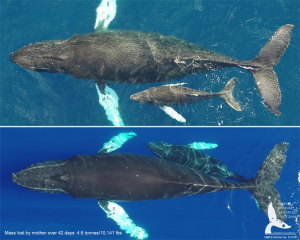
Vulnerable Newborn Humpbacks Are Being Born Further South—Why It Matters for Whale Conservation
A pioneering study featured in Frontiers in Marine Science has challenged long-standing beliefs regarding the calving practices of humpback whales. In contrast to the accepted notion that these majestic creatures give birth solely in warm, tropical waters, recent findings have recorded over 200 instances of newborn humpback whale calves in temperate areas significantly farther south than previously recognized. This includes observations as far as Tasmania and New Zealand’s South Island—approximately 1,500 kilometers from known calving areas.
This finding, spearheaded by researchers from the University of New South Wales (UNSW), carries substantial ramifications for whale conservation, shipping regulations, and our comprehension of marine mammal ecology.
Birth Along the “Humpback Highway”
Humpback whales are renowned for their impressive migrations, traveling thousands of kilometers between nutrient-rich Antarctic feeding zones and warmer tropical waters, where it was believed they calved in protected settings. The revelation that humpbacks are indeed bearing calves along their migratory path—along what scientists have identified as the “humpback highway”—indicates that these animals possess a far more flexible birthing strategy than previously thought.
“Numerous humpback calves were born well beyond the known breeding grounds,” stated Dr. Tracey Rogers, the study’s senior author. “Birthing along the ‘humpback highway’ means these delicate calves, who lack strong swimming ability, must navigate long distances much earlier in their lives than if they were born in the designated breeding areas.”
This new maternal behavior presents challenges for calves just hours or days old, who are required to traverse open ocean right away in some of the busiest waterways close to urban shorelines.
An Unexpected Discovery Engenders Broader Research
The research was initiated by an unexpected sighting in July 2023, when Jane McPhee-Frew, a UNSW PhD candidate and lead author of the study, encountered a newborn calf alongside its mother at the entrance of Newcastle Harbor—Eastern Australia’s busiest commercial port.
“It seemed odd to me at first,” remarked McPhee-Frew. “However, many colleagues in the whale-watching sector weren’t surprised—indicating this could be more frequent than we thought.”
This observation sparked a wider investigation, gathering data from citizen scientists, marine photographers, government agencies, and historical records. From various sources, the team recorded 209 newborns, which included 11 observed births. Most notably, a calf was spotted near Port Arthur in Tasmania at 43° South—the northernmost latitude at which a humpback birth has ever been documented globally.
Ecological and Conservation Implications
This behavioral shift raises significant conservation issues. Unlike the relatively calm and sheltered tropical calving areas, temperate coastlines often feature heavy maritime traffic, fishing operations, and recreational water activities. Newborn whales and their mothers—especially in their initial days together—are particularly susceptible to risks such as:
– Collisions with large vessels in shipping routes
– Entanglement in fishing gear and shark control equipment
– Acoustic disturbances from boat engines and coastal construction
– Exposure to chemical pollution near urban areas
– Harassment or disturbance by recreational boats
“Rather than experiencing their most at-risk life stage in warm, less disruptive waters, these calves are instantly maneuvering through dangerous and heavily trafficked coastal zones,” stated Dr. Vanessa Pirotta, a co-author and marine mammal expert at Macquarie University.
Historic Patterns Overlooked by Near-Extinction
Interestingly, this unexpected behavior may not be unprecedented—it’s merely been concealed. During the peak of commercial whaling in the 19th and early 20th centuries, humpback populations in Eastern Australia were nearly driven to extinction. Today, their numbers have rebounded impressively, estimated at over 50,000 individuals.
“I believe this pattern has very likely existed all along, but previously, the whale population was insufficient for us to observe it,” explained McPhee-Frew. Supporting this assertion, 19th-century whaling records document sightings of mother and calf pairs at similar southern latitudes.
This indicates that the recovering population is reestablishing portions of its historic range, reflecting not just numerical improvement but also behavioral regeneration—a sign of a robust and resilient population.
Why Do Whales Migrate At All?
The study also prompts fundamental inquiries regarding the motivations behind whale migration and calving preferences. If humpbacks can successfully give birth in colder, busier waters, why make the lengthy and perilous journey to tropical regions?
Researchers theorize there may still be survival benefits to tropical birthing—warmer waters may reduce the risk of hypothermia in newborns, and fewer predators might threaten the calves. Nevertheless, it is becoming increasingly evident that migration choices hinge on a complex set of factors, encompassing oceanographic conditions, maternal readiness, and possibly social or learned behaviors.
This new data suggests that instead of perceiving migration as a direct route from Point A (feeding) to Point B (birthing),